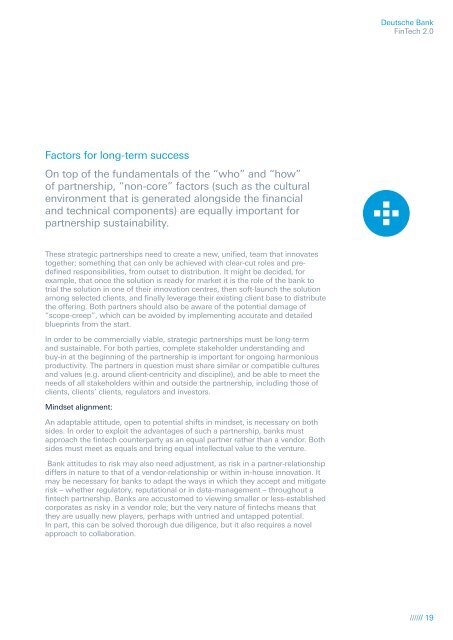FinTech 2.0
YKHHI
YKHHI
Create successful ePaper yourself
Turn your PDF publications into a flip-book with our unique Google optimized e-Paper software.
Deutsche Bank<br />
<strong>FinTech</strong> <strong>2.0</strong><br />
Factors for long-term success<br />
On top of the fundamentals of the “who” and “how”<br />
of partnership, “non-core” factors (such as the cultural<br />
environment that is generated alongside the financial<br />
and technical components) are equally important for<br />
partnership sustainability.<br />
These strategic partnerships need to create a new, unified, team that innovates<br />
together; something that can only be achieved with clear-cut roles and predefined<br />
responsibilities, from outset to distribution. It might be decided, for<br />
example, that once the solution is ready for market it is the role of the bank to<br />
trial the solution in one of their innovation centres, then soft-launch the solution<br />
among selected clients, and finally leverage their existing client base to distribute<br />
the offering. Both partners should also be aware of the potential damage of<br />
“scope-creep”, which can be avoided by implementing accurate and detailed<br />
blueprints from the start.<br />
In order to be commercially viable, strategic partnerships must be long-term<br />
and sustainable. For both parties, complete stakeholder understanding and<br />
buy-in at the beginning of the partnership is important for ongoing harmonious<br />
productivity. The partners in question must share similar or compatible cultures<br />
and values (e.g. around client-centricity and discipline), and be able to meet the<br />
needs of all stakeholders within and outside the partnership, including those of<br />
clients, clients’ clients, regulators and investors.<br />
Mindset alignment:<br />
An adaptable attitude, open to potential shifts in mindset, is necessary on both<br />
sides. In order to exploit the advantages of such a partnership, banks must<br />
approach the fintech counterparty as an equal partner rather than a vendor. Both<br />
sides must meet as equals and bring equal intellectual value to the venture.<br />
Bank attitudes to risk may also need adjustment, as risk in a partner-relationship<br />
differs in nature to that of a vendor-relationship or within in-house innovation. It<br />
may be necessary for banks to adapt the ways in which they accept and mitigate<br />
risk – whether regulatory, reputational or in data-management – throughout a<br />
fintech partnership. Banks are accustomed to viewing smaller or less-established<br />
corporates as risky in a vendor role; but the very nature of fintechs means that<br />
they are usually new players, perhaps with untried and untapped potential.<br />
In part, this can be solved thorough due diligence, but it also requires a novel<br />
approach to collaboration.<br />
////// 19


